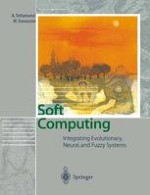2001 | OriginalPaper | Buchkapitel
Natural Parallel (Soft) Computing
verfasst von : Andrea Tettamanzi, Marco Tomassini
Erschienen in: Soft Computing
Verlag: Springer Berlin Heidelberg
Enthalten in: Professional Book Archive
Aktivieren Sie unsere intelligente Suche, um passende Fachinhalte oder Patente zu finden.
Wählen Sie Textabschnitte aus um mit Künstlicher Intelligenz passenden Patente zu finden. powered by
Markieren Sie Textabschnitte, um KI-gestützt weitere passende Inhalte zu finden. powered by
Many problem solving and heuristic techniques, including those typical of soft computing, have the distinctive feature of being directly or indirectly inspired by the observation of the natural world. If we look, for instance, into such processes as biological evolution or the functioning of the brain, we notice that many things are happening at the same time. The same can be said of many other natural systems such as insect societies and ecologies in general. In other words, these systems are natural massively parallel ones where more or less simple agents, such as nervous cells or ants, work jointly, in a distributed manner, to sustain the whole or to “solve” a problem. In short, many, if not all, natural systems work on a problem in a collective, concerted manner. Of course, collectively “solving” a problem does not have the same meaning in nature as in the sciences. Solving a problem might mean building a bee nest, firing a few million interconnected neurons in response to a stimulus, or just surviving in an animal ecology. There is no explicit concept of “optimizing” something, nor of finding a particular solution, just of adapting so as to maintain collective viability in the face of a changing environment.
